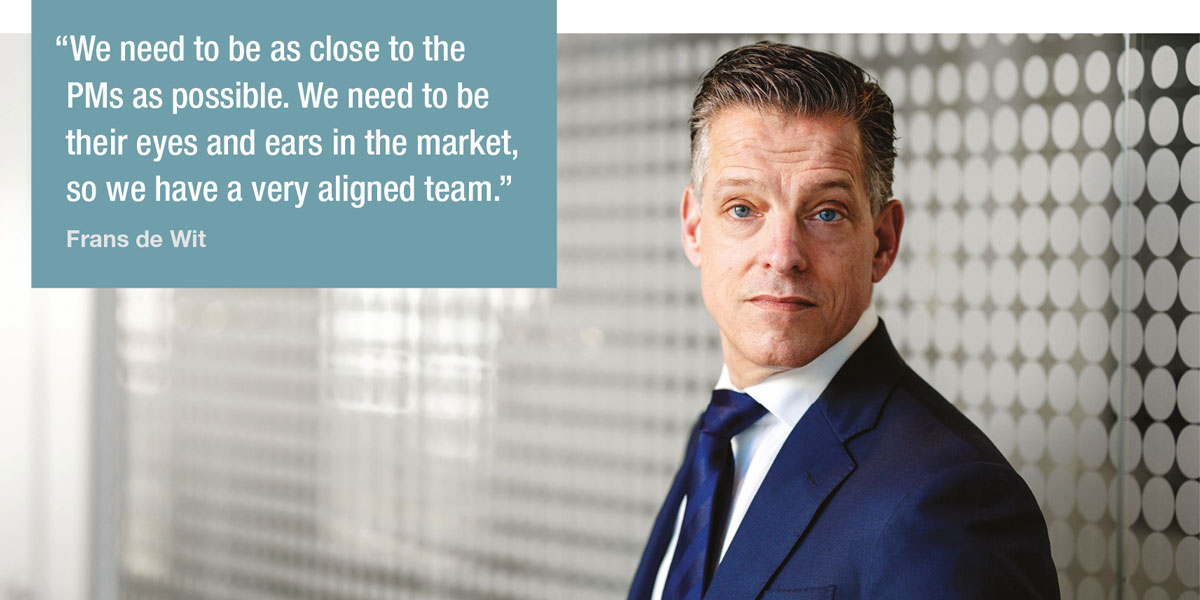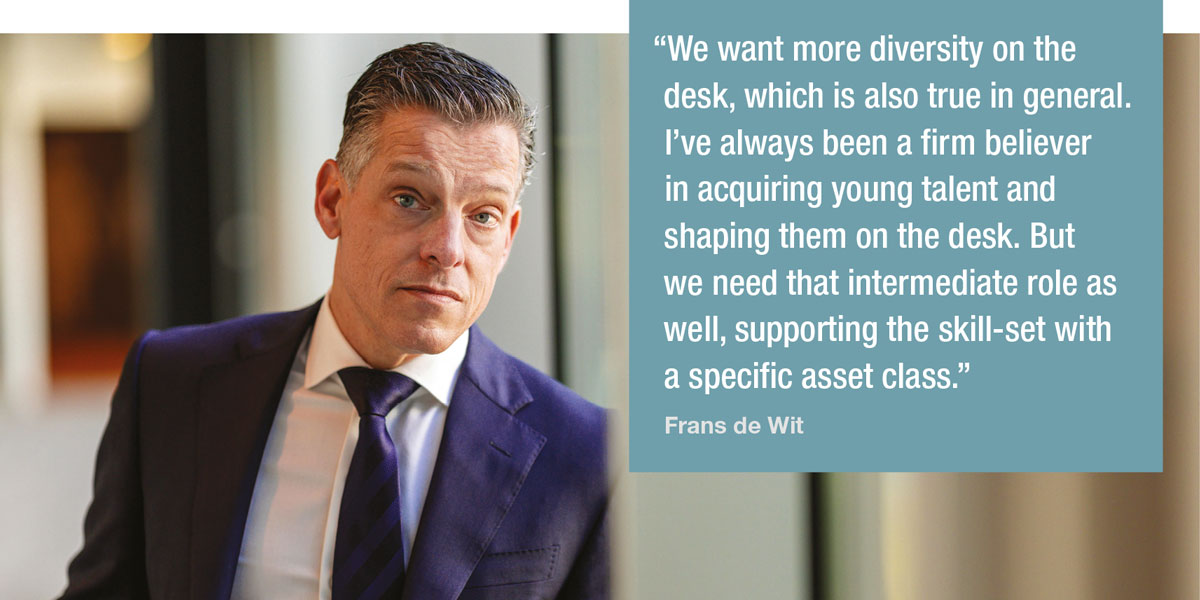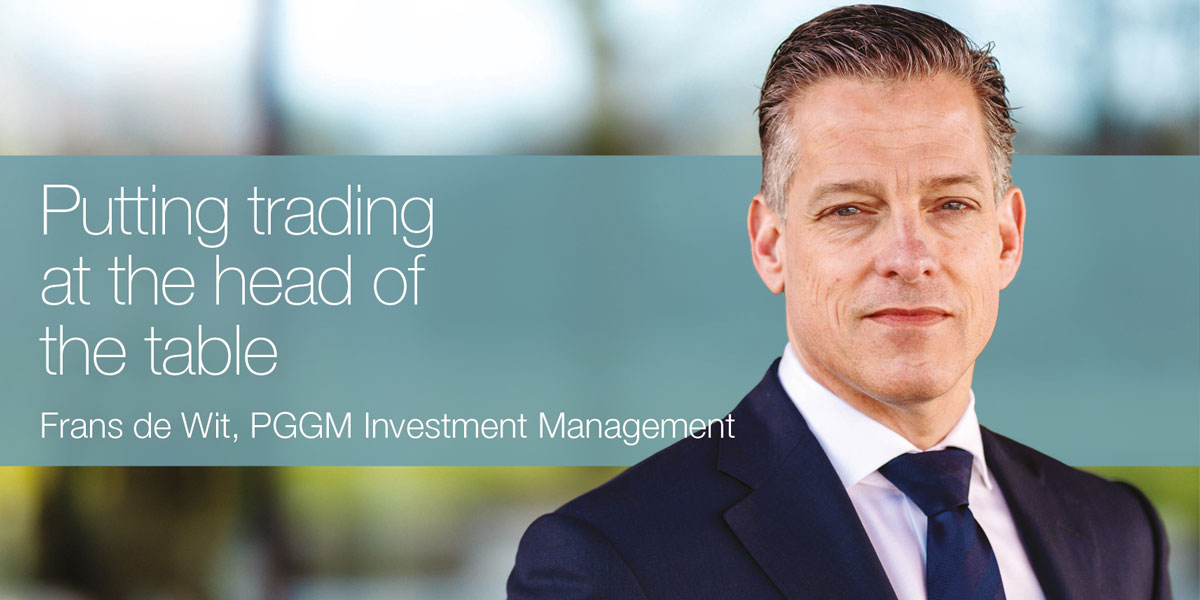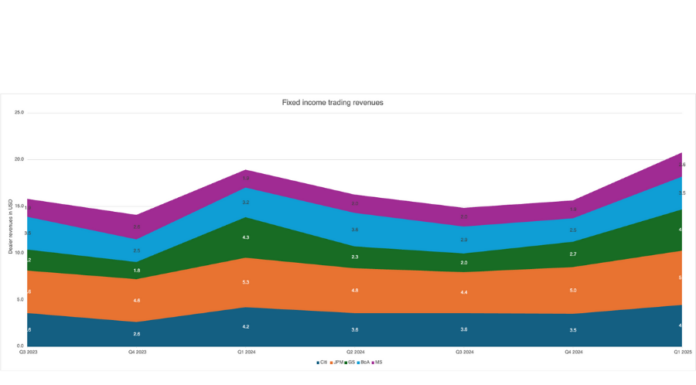Frans de Wit’s elevated role as head of trading at PGGM Investment Management will help improve execution quality and trading efficiency for end investors.
What has your recent promotion meant for you in managing trading?
First and foremost it gave us a seat at the table. Before this role, we had treasury, trading and commodities combined, run by one head. It was sometimes difficult to prioritise important topics per unit, as each had very specific issues. This role makes the whole picture clearer. It makes us solely focused on trading. Personally I have been developing the team for two and a half years on a daily basis, but without conducting duty reviews or making personnel changes, so the new role makes the lines clearer, both for me and for the team, and frankly, gives me a bigger toolbox to work with.
How do you represent the trading team within the firm and within the industry?
Internally I focus on what is most important for trading. Where do we need to be five years from now? What are the big challenges? What are the new developments in the market? The trading team runs FX, fixed income and equities, so how do we make sure that we all keep the ball moving in the same direction? My job is to make sure we start the process of changing, or moving towards a new target, quickly enough within the company.
Externally it’s up to me and the rest of the desk to make sure that we’re on top of changes in the market, so we know where the market is moving, and what takes priority, and taking part in working groups and trade association groups, going forward.
How would you describe your leadership style?
I grew up in commodities, at one point running the commodities desk by myself. I knew all the ins and outs of the portfolio. When I was allowed to expand the team and hire juniors I had to give them a little bit of that control. In the beginning I could be categorised as ‘directive’ because I looked at what the portfolio needed, and not necessarily at what the team needed. That’s not the way to go, so I changed my approach.
When I became involved with the trading team, all of a sudden, I had seniors that knew more about the market than I ever would, and I had to look at different ways of managing the team.
My style right now can be characterised as giving the team a lot of trust, and a lot of responsibility, to do the job as they see fit. I’m there to support them and keep us moving in the same direction. I’m personally allowing myself to show a bit more vulnerability, to create a team that works on the basis of trust. That suits me better.
Which markets does the team cover?
FX, fixed income and equities, worldwide. We need to be as close to the PMs as possible. We need to be their eyes and ears in the market, so we have a very aligned team. We don’t run our own book, limiting the number of people we can hire for a desk.
Which challenges are the greatest for your fixed income trading team?
The challenges on the horizon are multiple. Firstly whether to build/retain specialities within the team in combination with having enough people to provide continuity, and then retention of talent.
Depending on where you look, junior staff can be relatively easy to acquire but difficult to retain. Relative to their immediate seniors, over the past couple of years we see them moving around more quickly.
The second issue is when hiring a young senior, how do you mould them into an asset manager for a pension fund client? That is a specific kind of trading and is a challenge.
The final challenge is gathering the right data to support trading analysis and automation.

When you’re thinking about bringing juniors onto the desk do you see a challenge in bridging the skill-sets of voice vs electronic trading?
It happens organically to a certain extent as the markets are converging, right. Equities has always been leading the way and as that becomes settled the momentum trickles down to the other asset classes. Fixed income is moving, but more slowly. Like everyone else we’re limited in what we can do; it’s a constant struggle between keeping that speciality knowledge on the desk, and breeding or adding a new skill-set.
We’re trying to tackle this across assets by setting up a talent pool of junior traders. The skill-set is data-oriented, able to handle data analysis, and is familiar with automation. For a period of roughly two years, they will rotate across asset classes a couple of times, so they can cross-fertilise lessons they have learned between asset classes.
That approach helps with a couple of things. First, it helps us getting the right skill-set for automation of trading going forward. Secondly, we are retaining speciality knowledge within the senior traders. By rotating juniors, it also helps us to get seniors more involved in the process of automation.
How would you describe the challenges that buy-side firms face, in terms of getting the right resources for trading desks?
They are mainly around people. We want more diversity on the desk, which is also true in general. I’ve always been a firm believer in acquiring young talent and shaping them on the desk. But we need that intermediate role as well, supporting the skill-set with a specific asset class. The hybrid working environment makes it a lot easier as people don’t necessarily have to live close to the office. You can work from home these days, which makes recruitment a lot easier. For example we just hired an equity trader who is alternating working a week from home in the UK and then spending a week in the Netherlands, which makes it a lot easier for him to combine family life with a work/life balance.
Which technologies are you most optimistic about in supporting bond and fixed income traders?
As markets converge, more instruments become listed securities, therefore transparency increases in the market. That paves the way for automation. Specifically for the bond traders in IG credit as a good example, we see banks providing automated pricing mechanisms, from which we can stream prices, which is a very important development.
Analytics that help in gathering pre-trade data are also very helpful. Making sure we get the right data and the right elements to build a feedback loop from the post trade back into the pre-trade is about transparency and having the right data.
Is the automated pricing improving execution quality generally or more in providing continuous liquidity?
More liquidity on a continuous basis. It’s a healthy mix between transparency on the one hand, and being able to source liquidity on the other. In the equity market we see tickets cut up into smaller pieces, to be able to cope with that flow and transparency. We have to find a balance in fixed income, probably a longer retention period, for example.

That is an interesting point; how could trading workflows change in the future?
As markets become more transparent and market architecture becomes more platform or EMS agnostic, a lot of the trading will become more automated. Trading should be run from the junior pool that we’re setting up in the future. In the fixed income market, the periodic increased lack of liquidity makes data less relevant and traders are getting back on the phones, nurturing dealer relationships.
So the workflow is governed by a dual skill-set. We’re moving away from that slowly, when the bulk of the trades will be done now via straight-through-processing (STP). Change depends on the market, for some the structure is more difficult but ultimately, we’ll move in that direction.
Do you see potential barriers being created by market structure to effective and efficient trading?
The biggest barrier for fixed income is getting access to good data, the second is having the infrastructure to use that data.
We’re setting up an internal infrastructure to gather more data, to clean it, quantify and then use that data to create the feedback loop from post-trade to pre-trade. We’ve also recently set up a trading analytics desk, which is separate from the trading desk and they’re spearheading this process. That’s across asset classes, starting with equities and later adding other asset classes as well.
What is your opinion on the consolidated tape?
It’s going to help the gathering of data and increasing transparency in the market, for us less on price sensitivity or price discovery, and more volume discovery. The difficulty is how much transparency you want, and when do you want it?
A longer retention period of information would help. If we were to look for large blocks in the market, we could reignite the same trade [if it is not disclosed too early] instead of killing our own market. So we have to be careful in articulating how positive this could be. In general, the more transparency the better but it shouldn’t have too great an impact; as we discussed with equities, we see a lot of smaller clips now, and that isn’t necessarily a bad thing. Changing of market structure isn’t necessarily a bad thing but we should not move too quickly.
How do you see the roles of trader and portfolio manager evolving?
Where these roles used to be combined their differences are becoming more specialised. They will move away from each other which means that the role of trader is more important as the ears and eyes of the PM in the market.
Is that supporting the interest in outsourced trading, as trading can be separated out and standalone?
Given the limited amount of team resources that we have, we’re looking at the possibilities of being able to outsource trading in times of stress, sickness, etc. But I think it strongly depends on the type of asset manager you are. We have a large client, and tickets are generally large. The question of discretion [of managing orders] is the most important thing for us when we’re entering the market. That’s an element we have to get around before we can actually look at alternatives like partially outsourcing trading as an addition to our toolbox. We’ve just started to try to get our heads around this idea.
What is the value of machine learning in the trading space and in fixed income in particular?
Its use is inevitable, ultimately, helping in the process of automation. But we will be far down the road when we will be able to start using it in a decent capacity. When I started in commodities in 2003, the big debate was that by 2030, there would not be any oil left. And here we are easily going on for another good few years. So, pinpointing a moment of inevitable change is difficult.
Frans de Wit is head of trading at PGGM Investment Management. Frans obtained his master’s degree in Financial Economics at the University of Groningen and has been active in the market for the past 22 years holding different roles at PGGM, all related to trading. Frans sees the automation of trading processes, coupled with a convergence of market structure evolution, having had an ongoing, continuous influence on the design of the trading desk at PGGM. He emphasises the importance of continuing this development building on strong foundations in the PGGM trading team.
©Markets Media Europe 2023
©Markets Media Europe 2025
























